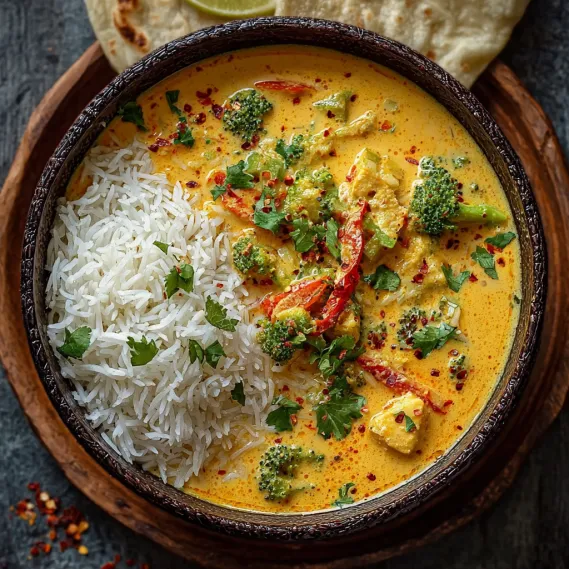 Pin
Pin
This creamy vegetable korma has been my secret weapon for impressing dinner guests while keeping meal prep simple. The rich, aromatic sauce paired with tender vegetables creates a restaurant-quality Indian dish that's surprisingly easy to make at home.
I first created this korma when I needed a crowd-pleasing dish for friends with different dietary preferences. The empty bowls and recipe requests afterward confirmed it was a keeper, and it's now my go-to when I want something special without spending hours in the kitchen.
Ingredients
- Vegetable oil or ghee: provides the authentic foundation for toasting spices and creates that distinctive Indian flavor profile
- Onion, garlic, and ginger: form the aromatic base that gives depth to the entire dish
- Canned tomatoes: add acidity and body to balance the creaminess of the coconut milk
- Curry powder, garam masala, and other spices: create layers of flavor that develop as they cook
- Coconut milk: provides the signature creamy texture without any dairy
- Butter beans: add protein and a buttery texture that absorbs the flavorful sauce
- Fresh cilantro: brightens the rich flavors and adds visual appeal
- Naan or basmati rice: completes the meal and helps soak up every bit of the delicious sauce
Step-by-Step Instructions
- Sauté the Aromatics:
- Heat oil or ghee in a large skillet over medium heat until it shimmers. Add onions and cook for a full 5-7 minutes, stirring occasionally until they become translucent and start to turn golden at the edges. This slow cooking process releases the natural sweetness that forms the foundation of your korma. Add garlic and ginger next, cooking just until fragrant about 1-2 minutes being careful not to let them burn as they can turn bitter quickly.
- Build the Tomato Base:
- Add tomatoes to the aromatic mixture and watch for the initial sizzle to subside. This indicates the tomatoes are beginning to break down and incorporate with the onion mixture. Stir frequently to prevent sticking as the mixture begins to thicken slightly and turn a deeper red.
- Toast the Spices:
- Sprinkle all the spices over the tomato mixture and stir continuously for about 5 minutes. You'll notice the aroma intensify dramatically during this stage as the heat activates the essential oils in the spices. The mixture will become fragrant and slightly darker as the spices toast in the oil. This critical step develops the complex flavor profile that makes korma special.
- Create the Sauce:
- Pour in the coconut milk slowly while stirring constantly to integrate it with the spice mixture. The sauce will transform from deep red to a beautiful golden orange color. Bring to a gentle simmer where small bubbles just break the surface but the mixture isn't rapidly boiling. Allow it to cook uncovered for 10 minutes, stirring occasionally to prevent a skin from forming. During this time, the sauce will thicken slightly and the flavors will meld together.
- Add Protein and Vegetables:
- Gently fold in the butter beans and any additional vegetables you're using. Submerge them completely in the sauce to ensure even cooking and flavor absorption. Simmer for another 5-10 minutes until vegetables reach your preferred tenderness. The beans should be warmed through but still maintain their shape without becoming mushy.
- Finish and Garnish:
- Taste the korma and adjust seasonings if needed. Add a squeeze of fresh lemon juice if you want to brighten the flavors. Remove from heat and let stand for 2-3 minutes to allow the sauce to settle and thicken slightly. Sprinkle generously with fresh herbs just before serving for the best flavor and appearance.

My absolute favorite thing about this korma is how the fennel seeds provide subtle bursts of anise flavor throughout the dish. I discovered this secret ingredient years ago when I ran out of traditional spices and improvised. Now my family notices immediately if I ever forget to include it. That distinctive flavor always brings back memories of the first time I made this for my parents who were skeptical about vegetarian Indian food but ended up requesting the recipe.
Perfect Vegetables for Korma
The beauty of vegetable korma lies in its versatility. While this recipe calls for butter beans as the protein component, you can create endless variations by adding different vegetables. Root vegetables like potatoes, carrots, and sweet potatoes work exceptionally well as they absorb the flavorful sauce while maintaining their texture. Cruciferous vegetables including cauliflower and broccoli add wonderful texture contrasts. For a more colorful korma, bell peppers, peas, and spinach not only add visual appeal but also nutritional variety. The key is cutting all vegetables into similar sized pieces to ensure even cooking. I recommend adding firmer vegetables earlier in the cooking process and more delicate ones like spinach in the final few minutes.
Making Ahead and Storage Tips
This korma actually improves with time as the flavors continue to develop and meld together. You can prepare it up to three days ahead and store it in an airtight container in the refrigerator. When reheating, add a splash of water or vegetable broth if the sauce has thickened too much. For longer storage, korma freezes beautifully for up to three months. I recommend portioning it into individual servings before freezing for quick meals. Thaw overnight in the refrigerator and gently reheat on the stovetop. The coconut milk may separate slightly after freezing, but simply whisk it well while reheating and the sauce will recombine.
Serving Suggestions Beyond Rice
While basmati rice is the traditional accompaniment to korma, exploring different serving options can transform this dish into multiple meals. Warm naan bread is perfect for scooping up the rich sauce, especially when lightly brushed with garlic butter. For a lighter option, serve korma over cauliflower rice or with a side of steamed vegetables. It also works wonderfully as a filling for baked potatoes or stuffed bell peppers. For a fusion approach, try serving it with quinoa or even over pasta. Complete your meal with cooling sides like cucumber raita, sliced fresh mango, or a simple kachumber salad to balance the rich flavors of the korma.
Common Questions About This Recipe
- → What vegetables work well in korma?
Classic choices include bell peppers, carrots, peas, and potatoes. Seasonal vegetables may also be added for extra flavor and texture.
- → Can I use something other than butter beans?
Absolutely. Chickpeas, lentils, or your preferred legumes make excellent substitutions for butter beans in this dish.
- → Is it possible to make this dish dairy-free?
Yes—since coconut milk is used, this korma is naturally dairy-free when prepared with vegetable oil instead of ghee.
- → What’s the best way to serve vegetable korma?
Basmati rice or warm naan are classic accompaniments, helping soak up the creamy, flavorful sauce.
- → How can I add extra texture?
Toss in toasted cashews or slivered almonds just before serving for an added crunch and nutty flavor.
- → Can this dish be prepared ahead of time?
Yes. Korma flavors deepen overnight, so it’s a great make-ahead option; simply reheat gently before serving.
